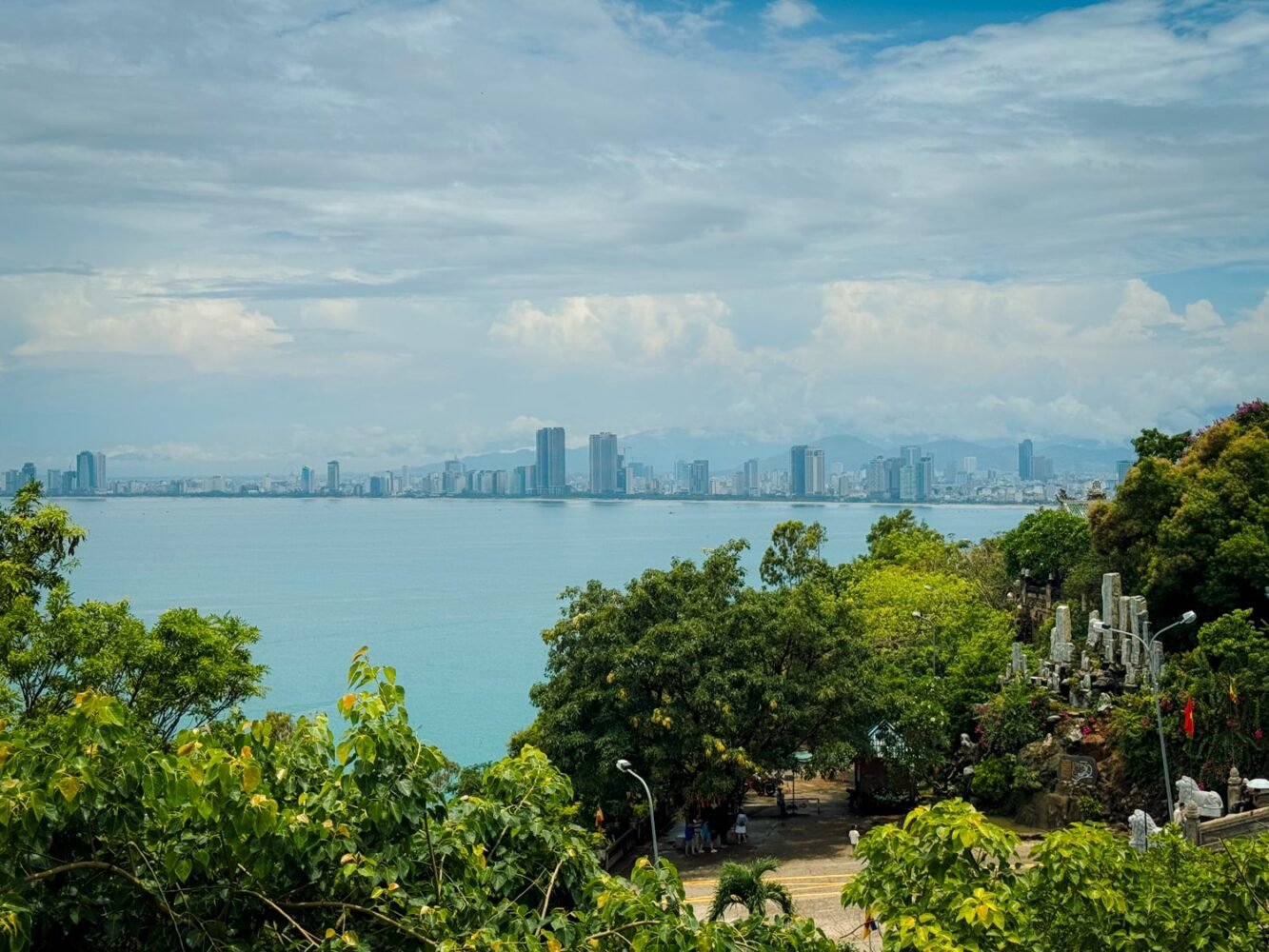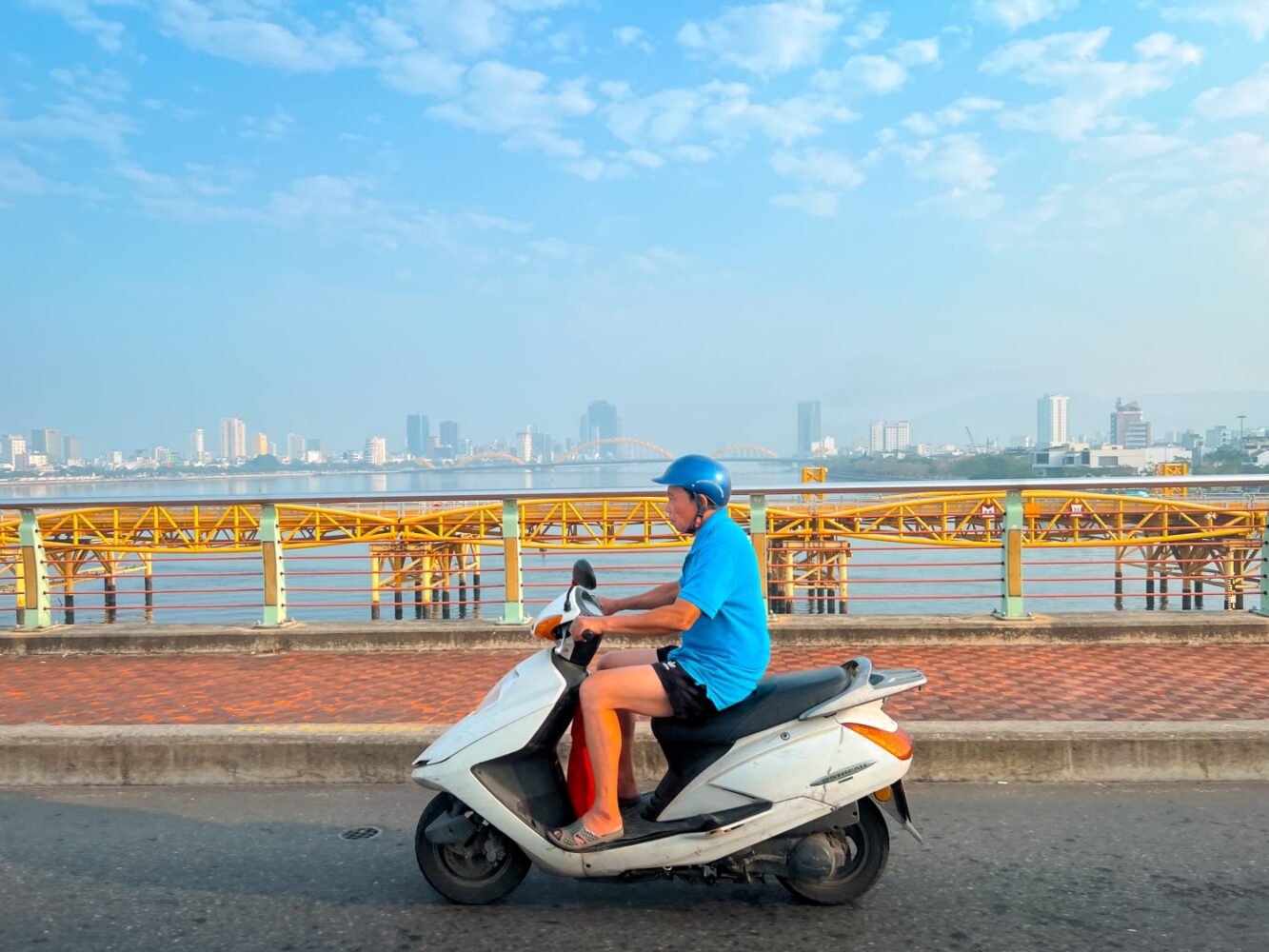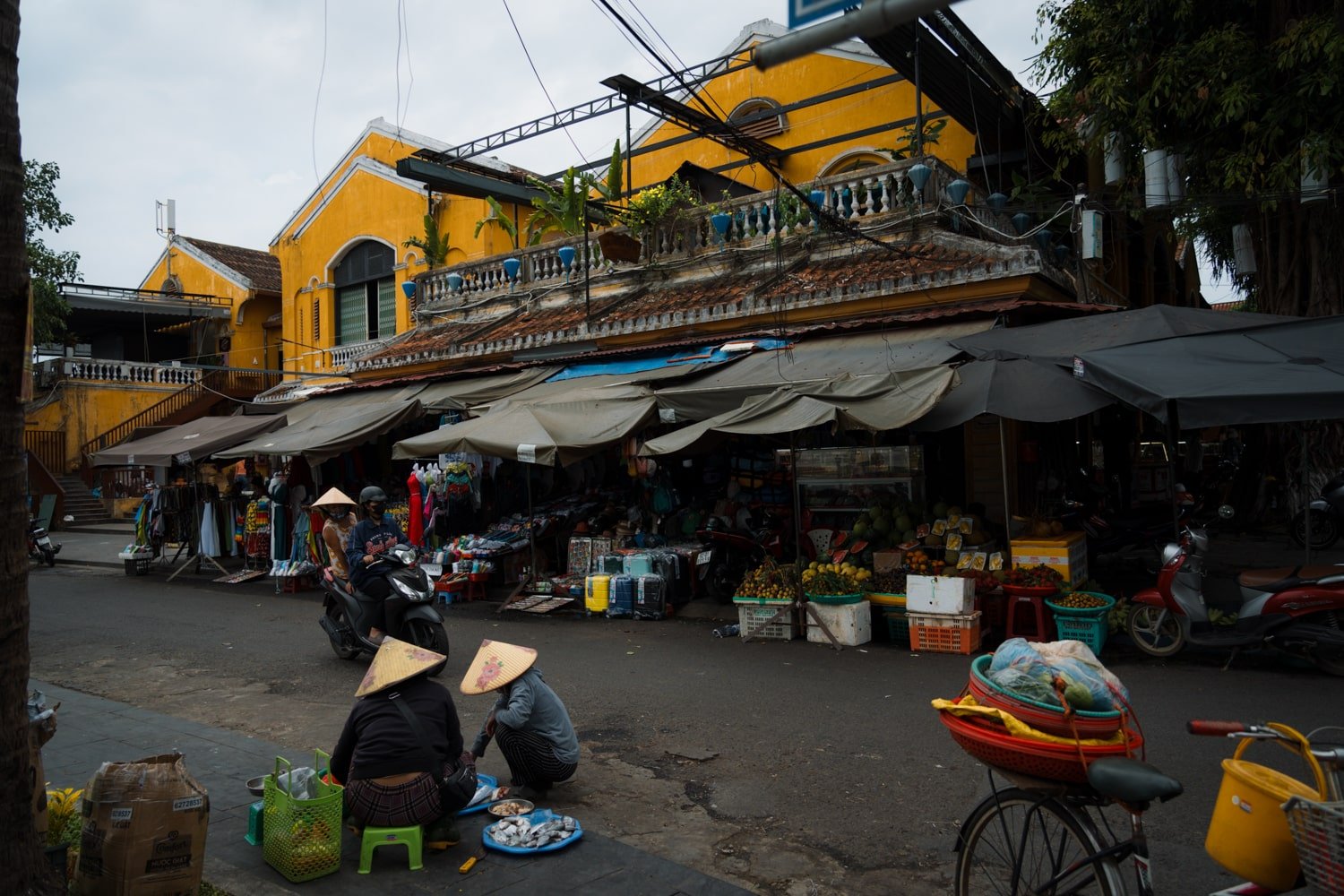The Ultimate Đà Nẵng Digital Nomad Guide: Living in Vietnam’s South Central Coast
17 min readFast WiFi, white sand beaches, a vibrant food scene, and amazing day trips are what digital nomads can expect from living in Đà Nẵng, Vietnam! 🇻🇳 Vietnam has been growing as...
The post The Ultimate Đà Nẵng Digital Nomad Guide: Living in Vietnam’s South Central Coast appeared first on Bucketlist Bri.
Disclosure: This post may contain affiliate links, which earn me a small commission from bookings at no extra cost to you. Thank you for reading and supporting my blog!
Fast WiFi, white sand beaches, a vibrant food scene, and amazing day trips are what digital nomads can expect from living in Đà Nẵng, Vietnam! 🇻🇳
Vietnam has been growing as a destination for foreign tourists in the last 10 years, and the expat and nomad community in Da Nang, in particular, is growing at a rapid pace.
With gorgeous oceanfront apartments at a fraction of the cost you’d find elsewhere, good transportation options (hi, Grab!), and an endless stream of cute and quirky cafes to work from, Da Nang is a great digital nomad spot.
We stayed in Da Nang on/off for 2+ months, traveling between Hoi An and around Vietnam’s South Central coast.

But it’s not all peaches and cream. ☺️
There are some things to consider when moving to Da Nang, Vietnam, as a digital nomad. From hot and sweaty weather to a million-plus population, living in this Southeast Asian country isn’t for everyone.
Whether you’re looking to spend a few months working from your laptop along Da Nang’s beautiful coast or thinking about dropping everything and making a more permanent move, this is your ultimate guide to Da Nang for digital nomads!
The Ultimate Guide to Da Nang, Vietnam for Digital Nomads
Before You Go — Da Nang Digital Nomad Essentials
So, you’ve decided on the digital nomad life in Vietnam! It will be an incredible adventure, but you should check a few things off your to-do list.
✈️ 1. Sign up for travel insurance: While healthcare in Vietnam is less expensive than in the United States, anything can happen. I highly advise you to sign up for travel medical insurance for extra security and comfort.
Unfortunately, emergencies like repatriation, emergency medical evacuation, motorbike accidents, and even electronic theft can happen while traveling or living in another country.
SafetyWing is my choice for travel insurance for digital nomads because its plans are super flexible and inexpensive.
Prices start at just $56 per four weeks, meaning you could spend as little as $28 to get insured for a two-week trip.
(Trust me, you will wish you had it when you want to cross the street in Vietnam and see a hundred scooters zooming around you 😂.)
📱 2. Download an eSIM: There’s nothing better than landing in a new country and having your phone work right away!
Download a Vietnam eSIM ahead of time so that you can activate it as soon as you arrive, and you’ll be ready to hail a Grab from your phone.
🇻🇳 3. Learn a few Vietnamese phrases: Vietnamese can be a bit difficult to learn, but a few phrases go a long way!
A simple hello, goodbye, and thank you should suffice, but you’ll earn some bonus points if you learn a few more.
Lucky for international travelers, Vietnamese use a Romanized alphabet versus characters, so it’s a little easier to sound out the words and recognize signage, etc.
Why Choose Da Nang vs Other Nomad Destinations in Vietnam?
Choosing Da Nang over one of Vietnam’s other incredible cities will ultimately come down to the lifestyle you’re looking to lead while living in Vietnam!
If an international airport, sparkling beaches, beautiful cafes, epic day trips, comfortable amenities, and the ability to get stuck into local culture appeal to you, Da Nang might be the perfect place to call home.
Da Nang offers the amenities and comforts of a big city with a noticeably more laid-back feel. It is a beach town, after all!

Some potential downsides to Da Nang are that it’s hot and humid year-round and a large city (over 1 million people!).
Still, Da Nang is spread out, and it doesn’t feel nearly as crowded as Hanoi or Ho Chi Minh City.
Some travelers do find that Da Nang is a bit more expensive than other cities in Vietnam, but considering that a coffee costs $1, the comparative cost of living is minor.
Instead of four seasons, Da Nang has a wet and dry season. The wet season can cause flooding in extreme years, and tropical storms hit from time to time.
While some find the rain tiresome, others find it a nice respite from the really hot, dry months.
Otherwise, there aren’t many faults in this tropical island on Vietnam’s coast.
Pros:
- Gorgeous beaches that are virtually empty until nightfall.
- An international airport.
- Cute cafes around every corner that are perfect for getting some work done!
- Lots of amazing day trips to take.
- Local culture isn’t difficult to find.
Cons:
- Hot and humid year round.
- Wet season.
- A large city of over 1 million people!
- Some find Da Nang to be more expensive than other Vietnamese cities.
Hoi An vs. Da Nang
While Hoi An is irresistibly charming and undoubtedly beautiful, it’s also a major tourist town. That means you’ll be sharing your home with thousands of visitors on an (almost) daily basis!
The heart of Hoi An can get crowded to the point of claustrophobia as tourists flock to see the historic center aglow with hundreds of colorful lanterns.
While Da Nang also sees its fair share of visitors looking to escape to the beach, the city is much larger than Hoi An, and you won’t feel the influx of travelers nearly as much.
Most visitors simply rush through Da Nang on their way to Hoi An’s enchanting cafes and night markets, which also helps with the crowds.
Living on the outskirts of Hoi An can be a good option, but most cafes, restaurants, and bars are in the center, where you might be fighting for a table in the evenings.

Hanoi vs. Da Nang
Da Nang might be a city of a million people, but it pales compared to the hustle and bustle of Vietnam’s capital, Hanoi.
When travelers say that Vietnam is overwhelming, many of them are talking about Hanoi and Ho Chi Minh City.
That being said, some visitors might not be able to handle the heat and humidity in Da Nang.
Hanoi cools off in the winter months, dipping to an average low temperature of about 60°F, while Da Nang never really cools to more than 70°F.
If you love big city living and leaning towards Hanoi, Da Nang is a city of over 1 million people.
You truly have the best of both worlds in Da Nang, city frenzy and the peaceful respite of the beach.
Where to Stay — Da Nang’s Best Neighborhoods
Take a peak at a map of Da Nang, and you’ll see two distinct sides of the city, which are divided by the Han River.
As a general rule, expats tend to live on the right side of the river near the beach, while the left side is much more residential/local.
Here’s a breakdown of Da Nang’s neighborhoods to help you decide where to stay!
My An/An Thuong
The My An neighborhood, also known as An Thuong, is tucked along the beach and is a trendy area of Da Nang where most tourists and expats stay. You’ll find a developed beach with palapas and water sports equipment for rent, as well as grocery stores, cafes, restaurants, and beachfront bars.
While this neighborhood is technically called My An, many refer to it as An Thuong because of the vertical streets that are all named An Thuong. If you want to be in the heart of it all with every amenity at your fingertips, this neighborhood is your best bet!
That being said, My An lacks cultural immersion as it is far from a local neighborhood. It can also feel touristy at times, especially in high season (generally from May to August).

Son Tra
If you want to live near the beach while still feeling like you’re entrenched in the local community, the Son Tra neighborhood is perfect for you! This area of town is at the north end of the beach strip and includes the Son Tra Peninsula.
Son Tra has much more of a local vibe with traditional markets and residential homes, while also being less expensive than neighborhoods like My Khe or An Thuong. The beach here isn’t nearly as developed as down the coast, but you’ll run into locals in the early morning and evening doing their daily exercises, swimming, and watching the sunrise or sunset.
Also, keep in mind that grocery stores, restaurants, and cafes are a little more spread out!
Khue My
A bit further south of An Thuong and heading towards the resort strip, Khue My is a serene, residential neighborhood sandwiched between the river and ocean. While it’s much more quiet than the hustle and bustle of An Thuong, you’re just a quick motorbike ride away while also having a few grocery stores and cafes around the corner.
Hai Chau
The Hai Chau neighborhood essentially encompasses most of the left side of the Han River. This area is considered Da Nang’s city center and closer to major transportation hubs like the airport and train station.
You’ll get a lot more bang for your buck in terms of accommodation in Hai Chau. If being close to the beach and international restaurants isn’t important to you and being immersed in local culture sounds appealing, Hai Chau might be your best bet!
Tip: Neighborhood and place names can get a little confusing in Da Nang. For example, the My Khe Beach area and Kheu My neighborhoods. It’s helpful to double check a map when looking for an apartment to make sure you’re where you want to be.

Accommodation — Finding Apartments & Co-livings in Da Nang
There are multiple ways to find accommodation in Da Nang, from apartments to sprawling villas.
Many expats hire an agent to help them if they’re looking for a long-term apartment—your best bet if you plan to live in Da Nang for more than just a few months.
Here are a few ideas for finding your home away from home in Da Nang.
Airbnb: For digital nomads in Da Nang planning to stay for a few months or less, finding an Airbnb on Airbnb can be a great option. It’s also usually possible to negotiate a better deal with the Airbnb host through messaging if you’re going to be staying for longer than a few weeks.
🌟 Booking.com can be another good tool when looking for apartments in Da Nang!
Facebook Groups: There are a few different Facebook groups for finding an apartment in Da Nang. One of the best is Da Nang Apartments for Expats, but you can also post in the Expats in Da Nang group or search recent posts to find apartments. The latter group is almost 60k strong and posts very regularly!
Co-living: Da Nang hasn’t quite caught on to the co-living trend like you’d expect from a destination with such a large expat community. There are only a few co-living options scattered around town, including Enouvo Space and Bridges. This will probably rapidly change in the coming years.
Remote Working — Da Nang’s WiFi, Co-Working Spaces, & Cafes
WiFi in Da Nang and most of Vietnam’s major cities (and even in the countryside) is ultra-fast!
Whether you’re working from your apartment or out at a cafe, you can almost guarantee that they’re going to have incredible upload and download speeds.
Likewise, local SIM cards are a good option and easy to find, although eSIMs work just as well.
There are so many amazing cafes to work from in Da Nang. You could probably spend an entire year testing them all out! Some of the best include…
- The Hideout Cafe
- The Hideout Cafe is a wonderful spot to work from in Da Nang. They have both a spacious interior and leafy patio to choose from and plenty of outlets. Aside from delicious coffee, they also serve sandwiches, salads, and the like. Hideout has a few locations on Da Nang’s beach side.
- Pine Cafe
- Pine Cafe might take the cake as the cutest cafe in Da Nang! Step inside to cozy vibes, cute ceramics for sale, origami decor, super friendly staff, and incredible coffee to boot. Their salted caramel latte and coconut coffee are the stuff of dreams. There are a few places to work inside, although outdoor seating is a little more limited.
- XLIII
- XLIII serves up some seriously gourmet coffee. While their prices reflect their dedication to coffee, it’s worth it for a special treat sometimes! The staff at Factory 43 (its official name) are also super friendly and willing to explain the process to you in detail. Coffee here is sourced from across the world.
- Wonderlust
- Situated on the “city” side of the river, Wonderlust is a bright, airy cafe that’s dripping with plants. There are several levels that you can hide away in to get some work done and their coconut coffee is incredible!
In the last few years, many coworking spaces have popped up around Da Nang, mostly concentrated in the beachfront area of the city.

Just a few of the best coworking spots you’ll find in Da Nang include:
- Seaview: One of the prettiest coworking spots in Da Nang, Seaview offers beautiful ocean views, 24/7 availability, and the ability to rent screens, standing desks, and other gadgets. You’ll also find amenities like free fruit, coffee, and community events. Monthly rates start at $75. Seaview is located near My Khe Beach.
- ACE: Another beautiful co-working space in Da Nang, ACE is perfectly set up to get some work done. Facilities include phone booths, private desks, monitors, meeting rooms, and even a social lounge. They also host fun community events, like pickleball meetups and lunches, and provide free water, tea, coffee, printing, and a discount at their cafe. Monthly rates are about $95, or $6 for the day.
- Enosta Space: Situated in the Son Tra neighborhood, Enosta Space is a small but cozy coworking spot to get some work done. They offer meeting rooms, communal desks, a lounge area, coffee, tea, and printing. Monthly rentals for a fixed desk are $90, although you can also rent a private office for about $290 a month.
Cost — Living in Da Nang as a Digital Nomad
Vietnam is one of the most cost-effective places in the world to be a digital nomad.
Here’s a glimpse at the cost of living in Da Nang:
Rent: Rent prices vary drastically in Da Nang, from around $400 for a local neighborhood and no-frills apartment to over $1,000 for a luxury villa with multiple bedrooms. There are some seriously opulent properties in Da Nang! You’ll pay more for ocean views versus mountain views (which are just as pretty).
Co-working space: Monthly memberships to coworking spots in Da Nang range from $75 to $95.
Eating out: How much you spend eating out depends entirely on what kind of food you’re looking for. Street food can cost as little as $1 (or even less!), while dinner at a Western restaurant ranges anywhere from $8-$15 for an entree.
Coffee: Vietnam is known for delicious coffee and Da Nang is no exception to the rule. There are cute coffee shops around every corner in this city! A fancy latte or cappuccino costs around $1-$2 on average. Simple coffee at a more local cafe could cost as little as $.50!
Alcohol: Beer is by far the least expensive option if you want to grab a drink in Vietnam. Expect to pay anywhere from $0.50 to a few dollars, depending on if it’s a draft craft beer or a Vietnamese beer in a can. The cost of wine and mixed drinks is drastically more expensive!
Groceries: Depending on where you buy your groceries, this runs the gamut of expense. If you pick up fresh fruit from a local market or stand, expect to pay a few dollars. If you’re going to one of the fancier grocery stores, prices will be drastically more expensive, but still less than if you were grocery shopping in Europe or the U.S./Canada.
Motorbike: Renting a motorbike in Da Nang will cost anywhere from around $120 to $300. Of course, this depends on what kind of motorbike you want! The more basic the motorbike, the less expensive it will be. A run-of-the-mill, basic scooter will generally cost about $4-$5 a day, while something more powerful can be upwards of $13 a day.
Transport — Getting Around Da Nang for Long Stays
Despite how sprawling the city of Da Nang is, it’s easy to get around! Whether you have the experience (and confidence!) to zoom through the city on a motorbike or you call a Grab to get around town, there are plenty of options to choose from.

Rent a Motorbike
Renting a motorbike is one of the most popular ways to get around Da Nang. Considering that the average cost to rent a motorbike per day is around $4, it’s also an inexpensive mode of transportation.
Keep in mind that the road rules in Vietnam can be tricky. Renting a motorbike here is not for the fainthearted. While you won’t find quite the traffic congestion as Hanoi or HCMC, Da Nang is still a city of over 1 million people. You might want to get your scooter feet under you before heading out on the roads here.
Make sure that you are provided helmets with your motorbike rental, and research traffic laws before you head out. It’s also a good idea to double check that your license will be accepted!
Grab
Grab is Vietnam’s version of Uber—only much less expensive! Calling a Grab is hands down the most efficient way to get around Da Nang, especially if you’re headed for the airport or train station.
You’ll have the option to choose a motorbike or a car to pick you up. A car is your safest bet, but riding on the back of a motorbike without having to do any driving is a fun option too!
Even those who do choose to get around by motorbike will probably use Grab more often during the rainy season.
Public Transportation
Da Nang has an extensive public bus system that spans the city, including buses that run to Hoi An. Tickets range from $1 to $1.50. While they’re very affordable, keep in mind that these local buses are often crowded and might not have A/C.
Walk
Most of the neighborhoods in Da Nang are walkable, with grocery stores, restaurants, and bars within an easy distance on foot.
The tricky part comes when trying to get from neighborhood to neighborhood in Da Nang, depending on where you’re located. Need to cross to the other side of the river? You’ll generally have to call a Grab, take a bus, or ride your motorbike.
Some neighborhoods, like My An and Khue My, are within walking distance to each other. But, for example, Son Tra and My An aren’t as easily connected on foot due to a lack of sidewalks.
Activities & Lifestyle — Things to do for Nomads in Da Nang
There are so many amazing activities and experiences to keep digital nomads occupied in Da Nang!
You could truly spend a year’s worth of weekends exploring without running out of things to do.
Swimming, paddleboarding, and surfing are some of the most popular fitness-related activities in Da Nang.
You’ll find lots of different shops renting water sports equipment at My Khe Beach. Although the waves aren’t huge, they’re perfect for beginner surfers and great for swimming!
There are also plenty of gyms, fitness centers, and yoga studios sprinkled throughout the city if you’re worried about staying in shape. The Da Nang Sports Meetup Group on Facebook is another great place to find classes and workout buddies!
Da Nang is also a great city for socializing, with bars and cafes galore. Watching the famous Dragon Bridge spew fire and water makes for a fun evening out, and there are plenty of other fun sites around the city, like the rosy pink Da Nang Cathedral, to seek out.
Outside the city, there are incredible day trips to keep you busy.

The Imperial City of Hue is just a short train ride north—one of the most beautiful in the country—and Hoi An is a quick bus south. You can also explore the Marble Mountains, the Cham Islands (just off the coast), or motorbike the legendary Hai Van Pass.
Closer to town, the mysterious Son Tra Peninsula beckons from across the sea.
You’ll notice the gleaming white Lady Buddha statue from the beach in Da Nang, easily accessed by Grab or motorbike. A rare species of monkey, the red-shanked douc langur, also lives on the peninsula, but it’s difficult to find them. You can sometimes see rhesus macaques at the temple to Lady Buddha (don’t try to feed or touch them).
Get in touch with the local expat community through Facebook pages like the 50k+ Expats in Da Nang to find local expat meetups and events. This Facebook page is your one stop shop for everything in Da Nang, from finding an apartment to hangouts!
Ethics — Being a Responsible Nomad in Vietnam
Whenever you’re visiting a different country—and especially when you’re planning to live in one on a more permanent basis—it’s a good idea to think about how you’ll do so as a responsible digital nomad!
Here are a few tips for living and traveling ethically in Vietnam:
Follow the rules.
Following the rules and local laws is essential, no matter where you’re visiting. Wearing appropriate clothing when visiting temples and spiritual places, removing your shoes when entering someone’s home (and at temples), and avoiding making a scene—a cultural taboo in Vietnam—are all good examples of respecting local customs.
In general, do a little research as to customs and etiquette in Vietnam, and you should be good to go!
Be mindful of the environment.
Like many digital nomad destinations, Da Nang has felt the weight of an influx in expats and travelers in recent years. Doing simple things like using a reusable water bottle and safe filters (like this one) goes a long way, especially in a country where the tap water isn’t safe to drink and many travelers grab plastic water bottles instead.
Leave no trace when visiting places like the beach. Da Nang’s beaches are beautiful and deserve to be kept clean!
Learn a few phrases in the local language.
Once again, learning a few phrases in the local language is so appreciated! This is even more important if you’re moving to a new country and planning to spend an extended period of time there. Many people in Vietnam speak English, especially the younger crowd and some older folks speak French, but learning a bit of Vietnamese is a simple courtesy.
Don’t price gouge.
Vietnam is an incredibly inexpensive country to live and travel in. Keep this in mind when you’re negotiating at a local market or searching for an apartment. The more foreigners are willing to pay for accommodation, the faster locals are bought out of certain neighborhoods, like An Thuong. It can be a tricky dichotomy to navigate.
Support local.
You’ll see a surprising amount of Korean businesses in Da Nang—especially grocery stores. Try to support local when you can! Most restaurants, bars, and cafes are locally owned so it isn’t too difficult.
Final Thoughts on Being a Digital Nomad in Da Nang
Da Nang might be one of Southeast Asia’s best digital nomad destinations.
You’ll spend your days and weekends cafe hopping, working from beautiful co-living sites, discovering the local culture, and diving tastebuds first into delicious and vibrant Vietnamese cuisine.
If you have any questions about being a digital nomad in Vietnam, be sure to leave them below!
I hope this guide helped you decide if Da Nang is the perfect place to spend a few months—or even settle permanently.
<!–
–>



